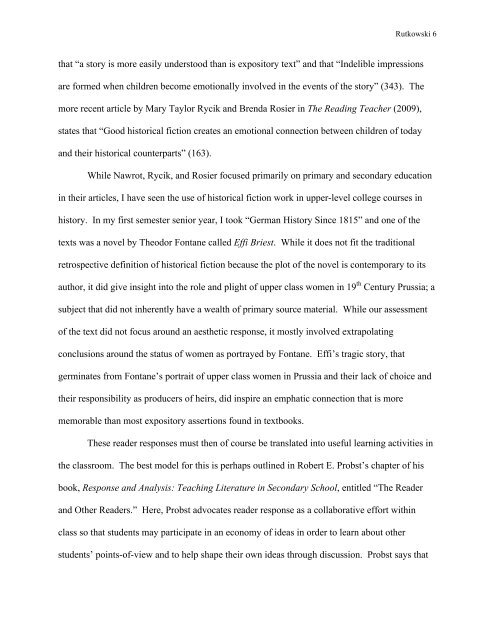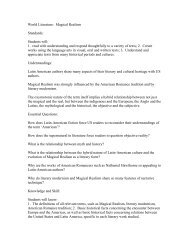Rutkowski 2011.pdf
Rutkowski 2011.pdf
Rutkowski 2011.pdf
- No tags were found...
You also want an ePaper? Increase the reach of your titles
YUMPU automatically turns print PDFs into web optimized ePapers that Google loves.
<strong>Rutkowski</strong> 6that “a story is more easily understood than is expository text” and that “Indelible impressionsare formed when children become emotionally involved in the events of the story” (343). Themore recent article by Mary Taylor Rycik and Brenda Rosier in The Reading Teacher (2009),states that “Good historical fiction creates an emotional connection between children of todayand their historical counterparts” (163).While Nawrot, Rycik, and Rosier focused primarily on primary and secondary educationin their articles, I have seen the use of historical fiction work in upper-level college courses inhistory. In my first semester senior year, I took “German History Since 1815” and one of thetexts was a novel by Theodor Fontane called Effi Briest. While it does not fit the traditionalretrospective definition of historical fiction because the plot of the novel is contemporary to itsauthor, it did give insight into the role and plight of upper class women in 19 th Century Prussia; asubject that did not inherently have a wealth of primary source material. While our assessmentof the text did not focus around an aesthetic response, it mostly involved extrapolatingconclusions around the status of women as portrayed by Fontane. Effi’s tragic story, thatgerminates from Fontane’s portrait of upper class women in Prussia and their lack of choice andtheir responsibility as producers of heirs, did inspire an emphatic connection that is morememorable than most expository assertions found in textbooks.These reader responses must then of course be translated into useful learning activities inthe classroom. The best model for this is perhaps outlined in Robert E. Probst’s chapter of hisbook, Response and Analysis: Teaching Literature in Secondary School, entitled “The Readerand Other Readers.” Here, Probst advocates reader response as a collaborative effort withinclass so that students may participate in an economy of ideas in order to learn about otherstudents’ points-of-view and to help shape their own ideas through discussion. Probst says that



